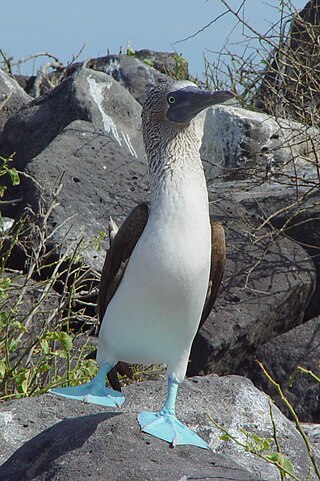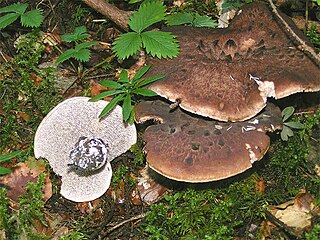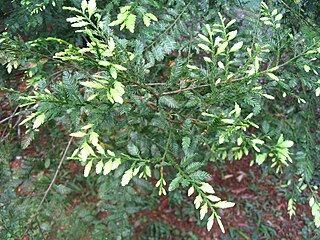
A booby is a seabird in the genus Sula, part of the family Sulidae. Boobies are closely related to the gannets (Morus), which were formerly included in Sula.

The Thelephorales are an order of fungi in the class Agaricomycetes. The order includes corticioid and hydnoid fungi, together with a few polypores and clavarioid species. Most fungi within the Thelephorales are ectomycorrhizal. None is of any great economic importance, though Sarcodon imbricatus is edible and commercially marketed, whilst several species have been used for craft dyeing.

The big-eared pipistrelle is a species of vesper bat in the family Vespertilionidae. It can be found in Indonesia and Malaysia. It forages over mud flats over Peninsula Malaysia but its roosting activities are unknown. Its habitat is being threatened by deforestation for agriculture, plantations, logging and fires but how it affects this bat or if it is adaptable are unknown.

Dacrycarpus imbricatus is a species of conifer in the family Podocarpaceae. It is found in Cambodia, southern China, Fiji, Indonesia, Laos, Malaysia, Papua New Guinea, the Philippines, Thailand, Vanuatu, and Vietnam. It is a tall tree up to 40 metres (130 ft) high.
Dacrydium gracile is a species of conifer in the family Podocarpaceae. It is found only in Malaysian Borneo.

The carrot-tail viper gecko is a species of gecko. It is found in Iran, Pakistan and possibly India, although the Indian records are questionable.

The Bhutan laughingthrush is a species of bird in the family Leiothrichidae. It is commonly found in Bhutan and some adjoining areas in India. It was formerly considered a subspecies of the streaked laughingthrush, G. lineatus, hence its alternate common name of Himalayan streaked laughingthrush.

Nesodon is a genus of Miocene mammal belonging to the extinct order Notoungulata which inhabited southern South America during the Late Oligocene to Miocene living from 29.0 to 16.3 Ma and existed for approximately 12.7 million years. It had a relatively large size, weighing up to 554 kg (1221 lbs) and reaching 1.5 m in height.

Sarcodon imbricatus, commonly known as the shingled hedgehog or scaly hedgehog, is a species of tooth fungus in the order Thelephorales. The mushroom is edible. Many sources report it has a bitter taste, but others have found it delicious and suspect that the bitter specimens may be similar related species. The mushroom has a large, brownish cap with large brown scales and may reach 30 cm (12 in) in diameter. On the underside it sports greyish, brittle teeth instead of gills, and has white flesh. Its spore print is brown. It is associated with spruce (Picea), appearing in autumn. It ranges throughout North America and Europe, although collections from the British Isles are now assigned to the similar species Sarcodon squamosus.

Urasterella is an extinct genus of sea stars that lived from the Ordovician to the Devonian. Its fossils are known from Europe, North America and southern Africa.

The Cardamom Mountains rain forests is a tropical moist broadleaf forest ecoregion in Southeast Asia, as identified by the WWF. The ecoregion covers the Cardamom Mountains and Elephant Mountains and the adjacent coastal lowlands in eastern Thailand and southwestern Cambodia, as well as the Vietnamese island of Dao Phu Quoc.

Stegastes imbricatus, commonly called the Cape Verde gregory, is a damselfish of the family Pomacentridae. It is native to the tropical eastern Atlantic Ocean.

The Canary damsel, or Cape Verde gregory is a species of marine fish of the family Pomacentridae. It lives primary in shallow, subtropical waters of the eastern Atlantic Ocean.

Ataenius imbricatus is a species of aphodiine dung beetle in the family Scarabaeidae. It is found in the Caribbean, Central America, North America, and South America.

Epicaerus imbricatus, the imbricated snout beetle, is a species of broad-nosed weevil in the family Curculionidae. It is found in North America.

Heterodactylus imbricatus, the Rio de Janeiro teiid, is a species of lizard in the family Gymnophthalmidae. It is endemic to Brazil.

Gladiolus imbricatus is a Gladiolus species.
Sorocephalus imbricatus, the tile-leaf clusterhead, is a flower-bearing shrub that belongs to the genus Sorocephalus and forms part of the fynbos. The plant is native to the Western Cape where it is found in the Piketberg, Groot Winterhoek and Elandskloof mountains. However, plants were last observed at the latter two sites 50 years ago.
Cyperus imbricatus, also known as the shingle flatsedge, is a species of sedge that is native to sub-tropical and tropical areas of the world.

Barisia imbricata, also known commonly as the imbricate alligator lizard, the transvolcanic alligator lizard, and el escorpión de transvolcánico in Mexican Spanish, is a species of medium-sized lizard in the family Anguidae. The species is endemic to Mexico.

















